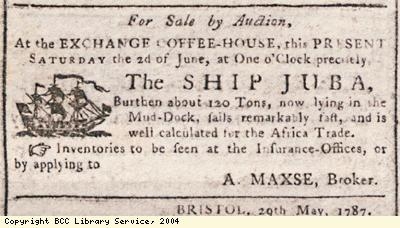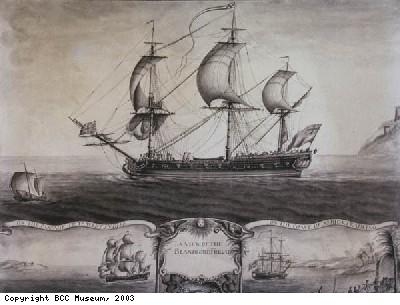

The Prince of Orange
The slave ship the Prince of Orange was owned by Richard Farr & Co, of Bristol. The captain on the 1736 voyage was Japhet Bird. This was the second slaving voyage out of four made by the ship whilst she was owned by Richard Farr & Co. On the coast of West Africa, at least 273 slaves were bought and survived the voyage across the Atlantic Ocean to be sold in the Caribbean. This picture of the slave ship the Jason Privateer shows enslaved Africans being put into a smaller boat to be taken to the waiting ship. The slaves would have boarded the ship the Prince of Orange in the same way.
Some of the enslaved Africans preferred death to whatever awaited them at the end of their voyage. 100 of the African men on the Prince of Orange jumped overboard near the island of St Kitts, in the Caribbean, and 33 of them drowned. “… more of them were taken up almost drowned, some of them died since, but not the owners loss, they being sold before any discovery was made of the injury the salt water had done them.”
The voyage made by the ship the Prince of Orange probably made a profit but it was a small one. The captain sold 240 slaves, and those injured by nearly drowning died after they were sold. The cost and profit of 33 slaves at least were lost, and there was little sugar to buy for the last leg of the journey back to Bristol. The triangular trade needed a good cargo on each leg to make a good profit.

The Marlborough
The ship the Marlborough was owned by William Lougher & Co of Bristol, and was captained by Robert Codd. The ship sailed from Bristol in March 1752 for West Africa, calling at Anamaboe and Bonny on the West African coast. This was her fourth and final slaving voyage.
By October, 420 slaves had been purchased, and the captain set out across the Atlantic Ocean to the Americas. Three days after leaving Bonny off the coast of West Africa, the ship was taken over by the enslaved Africans on board.
The captain used 28 of the slaves from the Gold Coast of West Africa to help sail the ship. These slaves led a successful uprising, or rebellion, when all the slaves were brought up on deck for washing. Several of the crew were killed in the fighting, and the remainder were made to sail the ship back to Bonny, in West Africa, by the enslaved Africans. Then the slaves from the areas of Bonny and the Gold Coast fought amongst themselves about returning home, and several were killed. The slaves from Bonny were sent ashore at Bonny, and the remaining seven crew set off with the other slaves for the Gold Coast. The ship and the crew were never seen again.
One of the crew, John Harris, survived when he rowed the slaves from Bonny ashore, and wrote his father a detailed letter about the incident which was published in Felix Farley’s Bristol Journal for 31 March 1753.
This voyage resulted in a loss to the owners. The money invested in the ship, trade goods and slaves was lost. The slaves from Bonny were free (although some may have been enslaved again later). It is not known whether the Gold Coast slaves reached home and freedom.
Slave uprisings on ships were often recorded in local newspapers. The one pictured here is from the Felix Farley’s Bristol Journal.

The Slave Ship "Juba"
The ship the Juba, owned by James Rogers & Co, sailed from Bristol in 1787, to Old Calabar (now Nigeria, West Africa) under Captain John Kennedy. This was her third and last slaving voyage, having gone twice to Africa for her previous owners Thomas Coulson & Co.
At Old Calabar, West Africa, 230 ‘prime slaves’ (that is, fit and healthy men and women) were purchased, plus 1½ tons of ivory, 28 barrels of oil made from palm nuts and 5 tons of redwood, a wood used to make dye.
The Middle Passage (the journey from Africa to the Caribbean) was very bad, taking 13 weeks instead of the usual 6. The ship’s surgeon accused the captain of beating and raping some of the women slaves. Despite this, the owner rehired the captain for other voyages. The 201 surviving slaves were sold on the Caribbean island of St Vincent. They were sold by George Baillie & Company who were acting as agents for the ship’s owners. The slaves were sold for an average of £33 6s 8d each. That would be about £1,650 today. Returning to Bristol, the ship and its goods sunk in the waters off Ireland.

The Juba’s bill of lading, an official record of the goods being carried on the ship, is pictured here. It tells us that the cargo loaded in Africa included ‘115 Males’ and ‘115 Females’, and ivory, oil made from palm nuts and wood used for making dye. Of the original 230 enslaved Africans, 201 survived the ‘Middle Passage’, between Africa and the Caribbean islands.
The owners made a profit, despite the deaths of 29 slaves and the loss of the ship. The costs for fitting out the ship were £4678 13s 3d (about £370,000 today). The proceeds of the sale of the slaves plus the insurance money for the ship and cargo came to £5835 13s 11d (about £450,000 today). This shows that even with such loses, slaving voyages could make the investors substantial profit.

The African Queen
The slaving ship the African Queen was another of Bristolian James Rogers’ ships. She left Bristol in 1792, with Samuel Stribling as captain, bound for Old Calabar (now Nigeria, West Africa).
According to one report, once there, the captain bought 255 enslaved Africans. Slaves were scarce and he spent months on the coast trying to buy enough to make the journey across the Atlantic Ocean to the Caribbean worthwhile.

At least 21 of the ship’s crew died during the 7 or 8 months spent at Old Calabar, waiting whilst the captain purchased slaves. One report says that of the 255 enslaved Africans on board, 28 died in this long wait at the coast, and 114 died in the Middle Passage from West Africa to the Caribbean. The crew and enslaved Africans would have become ill from spending so long onboard the ship, in cramped conditions where diseases spread quickly.
The ship arrived at Jamaica in the Caribbean in distress, and one agent refused to sell its cargo, because the slaves were in such bad condition. James Rogers’ ships had a much higher death rate amongst the slaves than other Bristol merchants. In 1793 Rogers went bankrupt. It is likely that this was in part due to his poor management of his voyages. The ship’s next slaving voyage, in 1794, was for new owners John Anderson & Co. (source: http://discoveringbristol.org.uk/slavery/routes/bristol-to-africa/shipping/four-ships-fortunes/)


I actually wanted to make a small remark so as to thank you for those great tactics
ReplyDeleteyou are giving out at this site. My time-consuming internet
lookup has finally been rewarded with brilliant content to go over with my family members.
I 'd admit that many of us readers actually are unquestionably endowed to dwell in a decent site with many marvellous people with valuable strategies. I feel really grateful to have come across the webpage and look forward to so many more enjoyable times reading here. Thanks a lot again for everything.
my webpage; michael kors crossbody bag
My husband and i felt absolutely happy when Albert could conclude his survey through the
ReplyDeleteentire precious recommendations he grabbed in your site. It's not at all simplistic to simply choose to be giving out methods which a number of people may have been making money from. And we also acknowledge we have got the writer to be grateful to for this. These explanations you made, the straightforward web site menu, the friendships you can help engender - it's many impressive,
and it is making our son and us reason why that theme is exciting, which
is certainly exceedingly serious. Thank you for the whole lot!
my site: michael kors mk5020 women¡¯s chronograph watch
Thank you a lot for providing individuals with an extraordinarily
ReplyDeletepleasant possiblity to discover important secrets from this
blog. It is usually very cool plus jam-packed with amusement
for me personally and my office peers to search the blog particularly
three times in a week to read the new items you have
got. Of course, I am at all times satisfied considering the excellent
principles served by you. Certain 4 facts on this page
are clearly the simplest I've ever had.
Stop by my web blog ... nike hyperdunk
Thanks for the auspicious writeup. It in truth was a leisure account it.
ReplyDeleteLook advanced to far brought agreeable from
you! However, how can we be in contact?
Here is my web-site ... shox nz
I want to get across my gratitude for your kind-heartedness giving
ReplyDeletesupport to individuals that actually need help on this one question.
Your special commitment to getting the solution all around came to be really important and have allowed those
much like me to realize their endeavors. Your amazing warm and friendly help and advice means a lot a person like me
and even more to my peers. With thanks; from all of us.
My web site: